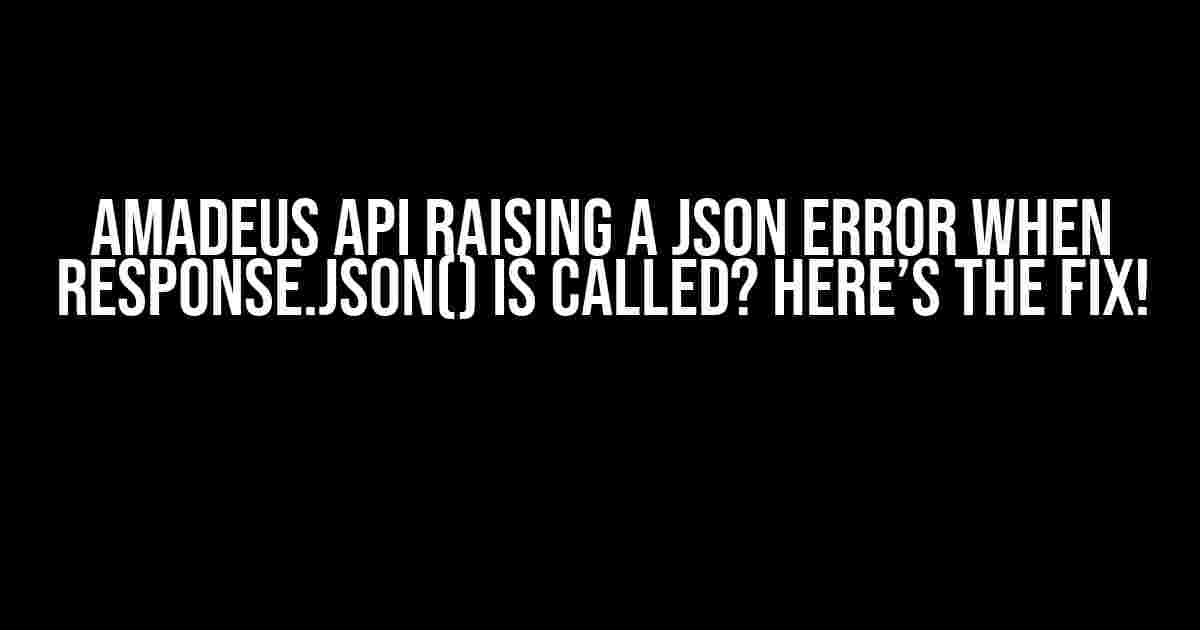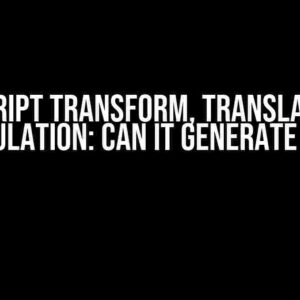If you’re reading this, chances are you’re stuck with a frustrating error while working with the Amadeus API. Don’t worry, we’ve all been there! In this article, we’ll dive into the common issue of Amadeus API raising a JSON error when calling response.json(), and provide you with step-by-step solutions to get you back on track.
What’s causing the error?
Before we dive into the fix, let’s understand what’s causing the error in the first place. The Amadeus API returns a JSON response, which you’re trying to parse using the response.json() method. However, sometimes the API might return an error or an invalid JSON response, which can cause the response.json() method to throw an exception.
Common Scenarios Leading to this Error
The Amadeus API might return an error or an invalid JSON response in the following scenarios:
- Invalid API Key or Credentials: Make sure you’re using a valid API key and credentials. If your credentials are invalid, the API will return an error.
- Rate Limit Exceeded: Amadeus API has rate limits in place to prevent abuse. If you’ve exceeded the rate limit, the API will return an error.
- Invalid Request Parameters: Check your request parameters to ensure they’re correct and properly formatted. Invalid parameters can cause the API to return an error.
- Network Issues: Network issues, such as connectivity problems or timeouts, can cause the API to return an error or an invalid JSON response.
Solutions to Fix the JSON Error
Now that we’ve identified the possible causes, let’s dive into the solutions to fix the JSON error:
Solution 1: Check the API Response Status Code
The first step is to check the API response status code. You can do this by checking the value of response.status_code:
import requests
response = requests.get('https://api.amadeus.com/v2/...')
if response.status_code == 200:
print('API returned a successful response')
else:
print('API returned an error:', response.text)
If the status code is not 200, it means the API returned an error. You can check the error message in the response.text.
Solution 2: Catch the JSONDecodeError Exception
You can catch the JSONDecodeError exception using a try-except block:
import requests
import json
response = requests.get('https://api.amadeus.com/v2/...')
try:
data = response.json()
except json.JSONDecodeError as e:
print('Error parsing JSON:', e)
This will catch the JSONDecodeError exception and print an error message if the JSON response is invalid.
Solution 3: Validate the API Response Content-Type
Make sure the API response content-type is application/json. You can check this using the response.headers dictionary:
import requests
response = requests.get('https://api.amadeus.com/v2/...')
if response.headers['Content-Type'] == 'application/json':
try:
data = response.json()
except json.JSONDecodeError as e:
print('Error parsing JSON:', e)
else:
print('Invalid content-type:', response.headers['Content-Type'])
If the content-type is not application/json, it might indicate that the API returned an error or an invalid JSON response.
Solution 4: Use the response.text Property
Instead of using response.json(), try using the response.text property to parse the JSON response manually:
import requests
import json
response = requests.get('https://api.amadeus.com/v2/...')
try:
data = json.loads(response.text)
except json.JSONDecodeError as e:
print('Error parsing JSON:', e)
This will parse the JSON response manually using the json.loads() function.
Additional Tips and Best Practices
To avoid running into this error in the future, make sure to follow these best practices:
- Handle Errors Gracefully: Always handle errors and exceptions gracefully using try-except blocks.
- Validate API Responses: Validate API responses to ensure they’re correct and properly formatted.
- Use Proper API Credentials: Make sure you’re using valid API credentials and keys.
- Monitor API Rate Limits: Monitor your API rate limits to avoid exceeding them.
- Test Your API Calls: Test your API calls thoroughly to ensure they’re working as expected.
Conclusion
In this article, we’ve covered the common issue of Amadeus API raising a JSON error when calling response.json(), and provided you with step-by-step solutions to fix the error. By following these solutions and best practices, you’ll be able to handle errors gracefully and ensure your API calls are working smoothly. Remember to always validate API responses, handle errors gracefully, and monitor API rate limits to avoid running into this error in the future.
| Solution | Description |
|---|---|
| Check API Response Status Code | Check the API response status code to ensure it’s 200. |
| Catch JSONDecodeError Exception | Catch the JSONDecodeError exception using a try-except block. |
| Validate API Response Content-Type | Validate the API response content-type to ensure it’s application/json. |
| Use response.text Property | Use the response.text property to parse the JSON response manually. |
We hope this article has been helpful in resolving the Amadeus API JSON error issue. If you have any further questions or concerns, feel free to ask in the comments!
Frequently Asked Question
Having trouble with the Amadeus API? We’ve got you covered! Check out these common questions and answers to help you navigate those pesky JSON errors.
Why am I getting a JSON error when I call response.json()?
This error usually occurs when the API returns a non-200 status code or an empty response. Make sure to check the status code before calling response.json(). You can do this by adding a conditional statement to check if the status code is 200 before attempting to parse the JSON.
How do I catch and handle JSON errors in my API call?
You can use a try-except block to catch the ValueError exception raised when response.json() encounters an error. This will allow you to handle the error and provide a more user-friendly experience. For example: try: response.json() except ValueError: print(“Error parsing JSON response”)
What does it mean when the API returns a non-200 status code?
A non-200 status code typically indicates an error or failure in the request. This could be due to a variety of reasons, such as invalid request parameters, authentication issues, or rate limit exceedances. Consult the Amadeus API documentation for a list of possible status codes and their meanings.
Can I still access the response content even if response.json() raises an error?
Yes, you can still access the response content using the response.text or response.content attributes. These attributes contain the raw response content, which you can then parse manually or log for debugging purposes.
How can I verify that the API is returning a valid JSON response?
You can use a tool like Postman or cURL to send a request to the API and inspect the response. Alternatively, you can log the response content or use a debugger to examine the response object. This will allow you to verify that the API is returning a valid JSON response.



